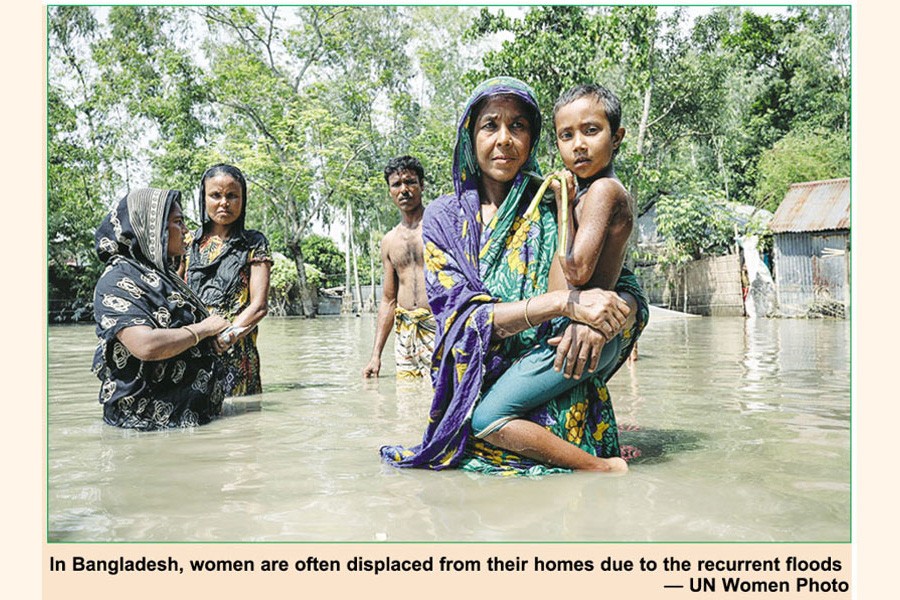
Closing gender gap: an essential tool to combat climate change
Babui Salsabil | Wednesday, 7 December 2022

 The COP27 Climate Conference saw world leaders and activists come together at Sharm el-Sheikh, Egypt, in November 2022 to catalyse global efforts to challenge the climate crisis. Among many unsettling issues that came to the forefront, one was that the gender gap in climate action was being bridged too slowly. It is quite unfortunate, though perhaps unsurprising, that women face the highest impacts of climate change, which exacerbates the already-existing gender inequalities across the various spheres of life. Women and girls are twice affected by climate change-initially, by the crisis itself, and additionally, by continued repercussions specific to women's lives.
The COP27 Climate Conference saw world leaders and activists come together at Sharm el-Sheikh, Egypt, in November 2022 to catalyse global efforts to challenge the climate crisis. Among many unsettling issues that came to the forefront, one was that the gender gap in climate action was being bridged too slowly. It is quite unfortunate, though perhaps unsurprising, that women face the highest impacts of climate change, which exacerbates the already-existing gender inequalities across the various spheres of life. Women and girls are twice affected by climate change-initially, by the crisis itself, and additionally, by continued repercussions specific to women's lives.
According to UN Women, climate change heightens the social, political and economic strains in fragile and conflict-ridden settings. Intensifying conflicts and discords, climate change subject women and girls to increased vulnerabilities manifest in forms of gender-based violence and discrimination. In the face of climate disasters, women face a higher chance of harm due to persistent gender disparities in terms of mobility, decision-making, access to resources, services, information, and so on. Such disasters often leave women and girls further susceptible to imminent disasters, thus creating a vicious cycle of vulnerability.
Similarly, a research study commissioned by Global Gender and Climate Alliance has revealed that across the world, women have a higher likelihood than men to be affected by climate-related food insecurity and are more prone to suffering from mental illness or partner violence following extreme weather events.
The research by Global Gender and Climate has also demonstrated that women and girls often encounter disproportionately higher health risks from the impacts of climate change compared to men and boys. Exploring 130 peer-reviewed studies,the analysis discovered that in 68 per cent of the study findings,women were affected more by the health impacts associated with climate change than men were. To illustrate its conclusions,the research showed that women and girls are more likely to die in heatwaves in France, China and India and in tropical cyclones in Bangladesh and the Philippines.
Climate change can even make everyday life harder for women, as is experienced by women in agriculture. For instance, during droughts the added burden of securing water often falls on the women.
How closing the gender gap helps address climate change better is shown in an analysis. According to Carbon Brief - a UK-based site specialising in the science and policy of climate change - a country's level of susceptibility to the impacts of climate change is largely dependent on how quickly it can adapt to the changes. Countries which can respond quickly to the effects of climate change are said to have a high "adaptive capacity". Often developed countries have higher adaptive capacities than their developing counterparts, partially owing to the former's investment capacities in the adaptive measures.Moreover, studies have found that a variety of factors, such as, income, education, access to healthcare services etc can affect one's level of vulnerability to the impacts of climate change.
Globally, many women remain markedly disadvantaged by these factors due to ingrained socioeconomic structures. As a result, the least gender-equal societies are often the most vulnerable to climate change. So, empowering women and girls through better-quality healthcare, education, and better representation in areas of decision-making could enable societies to adapt to the impacts of a changing climate more rapidly.
Let's see what can be done to close the gender gap. As it is evident that climate change affects women and girls disproportionately, leaving the already-vulnerable group further defenseless, comprehensive measures should be taken to address the challenges that they face as a result of climate change.
• Improving adaptive capacity: A study by the World Bank advocates for better investments in education and healthcare to build resilience as people with high levels of human capital are better-equipped to withstand shocks. Since women are predominantly deprived of such basic services, special focus should be given on women's access to education and healthcare. Additionally, well-targeted social -protection measures to safeguard basic levels of consumption, protect people from emergencies, capacity to diversify into livelihoods that are less climate vulnerable, and promote savings to guard against shocks would largely help women and men have stronger adaptive capacities to climate change.
• Investments in human capital while addressing existing inequities: Carbon-intensive industries are expected to see job losses in the near future. However, on the brighter side, World Bank research has estimated that climate business can generate up to 213 million cumulative jobs globally between 2020 and 2030. Investments in climate-smart technology can concurrently address climate change as well as generate employment.
Yet, these sectors require strong technical skills. To enable developing countries benefit from the transition to a low-carbon economy, focused trainings are needed to provide job-relevant skills for the newly created opportunities. This transition to greener jobs would also create a possibility to lessen the prevailing economic gender gaps by overcoming the pre-existing social norms around traditionally male-dominated sectors and promoting women's STEM skills.
• Better representation of women in decision-making: The UN Women's Executive Director has left some tasks at the COP27 to address the gender gaps to mitigate the effects of climate change. Her first ask was to take special measures, including quotas, to increase women and girls' equal and meaningful participation and leadership across all levels of decision-making, and to address inequalities including in their access to resources such as finance, technology, and land, especially women from poor and marginalized communities
The COP27 aimed to send a resounding message to the world that all countries, especially those with the greatest resources and capacities, and thereby, the highest responsibilities, are strongly involved and committed to combating climate change. However, it is the poorly resourced developing nations that continue to carry the bigger brunt of climate change, especially their disadvantaged women. And it is by being active agents of transformation in their own lives, rather than passive recipients of external help, that the susceptible women can change their vulnerable circumstances.
Therefore, it is not the obligation of any one group of nations or a single set of people to help the most vulnerable ones in this crisis, but rather a collective responsibility to combat and eventually prevail over the climate crisis by tackling all its root causes, among which gender gap is a key contributor.
Babui Salsabil is a development professional with expertise in international development and corporate banking. She has worked across multiple development projects, donor agencies, and multinational banks across South Asia and the USA. Babui is passionate about promoting economic and social justice. Currently, she is working as a consultant In Washington, DC, USA. For any questions, she can be reached at bs1091@georgetown.edu.